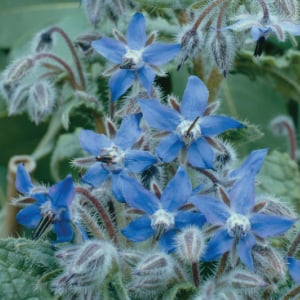
Learning Download: How to Grow Borage
From Seed to Harvest: A beginner’s guide to growing Borage.
Borage is an herb that grows edible flowers. The star-shaped flowers have a mild cucumber flavor and are a great added to salads or used as garnishes. In addition to adding it to salads, the leaves can be used to make tea. Borage plants can reach up to 2 feet in height and it native to the Middle East. Although the plant is an annual, it grows quickly and reseeds itself.
To plant:
Sow borage seeds directly into the garden after all danger of frost has passed. Plant seeds 1/4 to 1/2 inch deep in rows set 12 inches apart in an area that receives full sun. If planting in a garden, plant borage near strawberries as this will attract bees to the garden. If starting seeds indoors, plant three to four weeks before the last frost date. To ensure a long harvest season, sow seeds every four weeks. When planting, choose a site protected from the wind as borage plants can be delicate and easily blown over.
To grow:
Once borage plants reach 4 to 6 inches in height, thin the seedlings to 12 inches apart. Once the plant begins to bloom and the flowers begin to die, deadhead them to encourage more growth. In addition to planting borage near strawberries to bring bees to the garden, it is said the plant enhances the flavor of tomatoes if planted near each other, as well.
To harvest:
Once borage matures, harvest the leaves and flowers as needed. The plant leaves do not dry well, so use them fresh.
Pick the flowers before they have fully bloomed, and when harvesting, remove the leaves and flowers from the plant with your fingers or with scissors.
What borage craves:
Although borage doesn’t require much fertilizer other than amending the soil with compost prior to planting, the plant itself can be used as a fertilizer or a cover crop. Borage can be used as a green manure because of the plant’s deep taproot which brings nutrients to the surface of the soil. if borage is used as a cover crop, tilling the plant down after growth returns nitrogen to the soil. Borage serves as a good cover crop option not only because of the nutrients it returns to the soil, but the blooming flowers bring beauty to the garden. To use borage as a cover crop, plant in the spring or late summer. If planted in the late summer, the borage will grow but will not produce any flowers.
To use borage as a fertilizer, grow the plant normally and then strip the leaves. Barely cover the leaves with water, seal the container and steep the leaves for two weeks. Then drain the leaves and use the water as a natural fertilizer.
Where to buy borage seeds:
You can find borage seeds at Urban Farmer.

